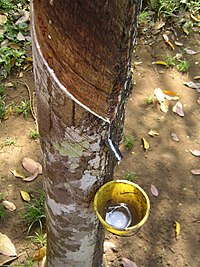
Photo from wikipedia
Natural rubber, an important industrial raw material with wide applications, is harvested in the form of latex (cytoplasm of rubber-producing laticifers) from Hevea brasiliensis (para rubber tree) by the way… Click to show full abstract
Natural rubber, an important industrial raw material with wide applications, is harvested in the form of latex (cytoplasm of rubber-producing laticifers) from Hevea brasiliensis (para rubber tree) by the way of tapping. Conspicuous stimulation on latex production is observed for the first few tappings conducted on virgin (untapped before) or resting (tapped before but no tapping for a period) rubber trees. To understand the underlying mechanisms, an integrative analysis of the latex transcriptome and proteome was conducted on virgin or resting Hevea trees for the first five tappings. A total of 505 non-redundant differentially expressed (DE) transcript-derived fragments (TDFs) were identified by silver-staining cDNA-AFLP, with 217 exhibiting patterns of upregulated, 180 downregulated and 108 irregularly-regulated. Meanwhile, 117 two dimensional gel electrophoresis DE-protein spots were isolated and subjected to mass spectrometry analysis, with 89 and 57 being successfully identified by MALDI-TOF and MALDI-TOF/TOF, respectively. About 72.5% DE-TDFs and 76.1% DE-proteins were functionally annotated and categorized. Noteworthily, most of the DE-TDFs implicated in sugar transport and metabolism as well as rubber biosynthesis were upregulated by the tapping treatment. The importance of sugar metabolism in harvesting-induced latex production was reinforced by the identification of abundant relevant DE-protein spots. About 83.8% of the randomly selected DE-TDFs were validated for expression patterns by semi-quantitative RT-PCR, and an 89.7% consistency for the 29 latex regeneration-related DE-TDFs examined by quantitative RT-PCR analysis. In brief, our results reveal extensive physiological and molecular changes in Hevea laticifers incurred by the tapping treatment, and the vast number of DE genes and proteins identified here contribute to unraveling the gene regulatory network of tapping-stimulated latex production.
Journal Title: Frontiers in Genetics
Year Published: 2022
Link to full text (if available)
Share on Social Media: Sign Up to like & get
recommendations!